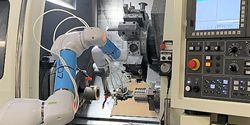Welcome to the Age of the Cobot
Collaborative robots can bring significant benefits through closer interactions with humans - but they need high-quality parts replacement to ensure safety and productivity
Machine Shop Robots Get Real
To better understand the benefits of cobot automation and how it works on the shop floor, we spoke to two leading providers of automated tools to small shops targeting two of the most time consuming and difficult to staff processes, quality control and welding.
Successfully Implement a Cobot into your Operations: Step 2 - What Role Do Integrators Play In This Process?
An integrator will definitely get the job done, but beware of a few potential pitfalls. Not all integrators are familiar with cobots. Those who treat the project like an industrial robot can negate many of a cobot's benefits.
Successfully Implement a Cobot into your Operations: Step 1
By now everyone knows what a Cobot is, but many aren't sure if they are ready, or if they are, how to successfully go about implementing into their day-to-day production processes.
Post-Pandemic Operations Must Incorporate Real People into the Automation Process
In a time when the whole world is re-evaluating the way they do business, it is essential that industries utilizing Smart Factory and automated solutions do not become over-reliant on technology to get the job done.
How Humans & Tech Harmonize in Manufacturing Industry
Robots allow employees to focus on tasks that require greater cognitive skills. Collaborative robots can be used for repetitive tasks as well as those that require detailed precision, such as applying a consistent amount of adhesive in an exact, repeatable location.
Records 1 to 6 of 6
Featured Product

T.J. Davies' Retention Knobs
Our retention knobs are manufactured above international standards or to machine builder specifications. Retention knobs are manufactured utilizing AMS-6274/AISI-8620 alloy steel drawn in the United States. Threads are single-pointed on our lathes while manufacturing all other retention knob features to ensure high concentricity. Our process ensures that our threads are balanced (lead in/lead out at 180 degrees.) Each retention knob is carburized (hardened) to 58-62HRC, and case depth is .020-.030. Core hardness 40HRC. Each retention knob is coated utilizing a hot black oxide coating to military specifications. Our retention knobs are 100% covered in black oxide to prevent rust. All retention knob surfaces (not just mating surfaces) have a precision finish of 32 RMA micro or better: ISO grade 6N. Each retention knob is magnetic particle tested and tested at 2.5 times the pulling force of the drawbar. Certifications are maintained for each step in the manufacturing process for traceability.






